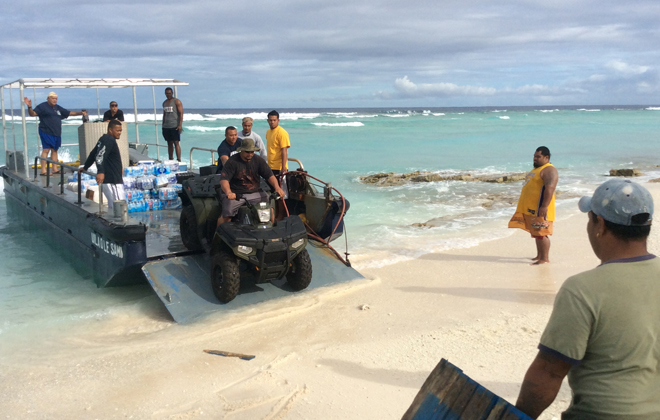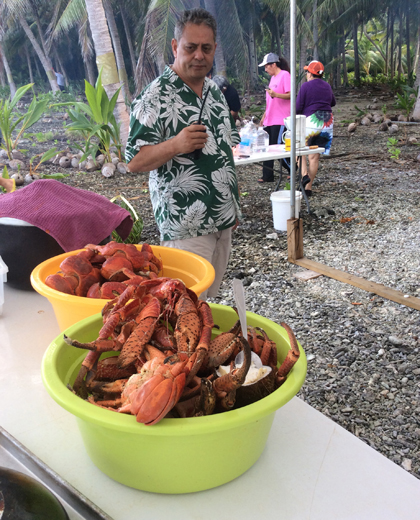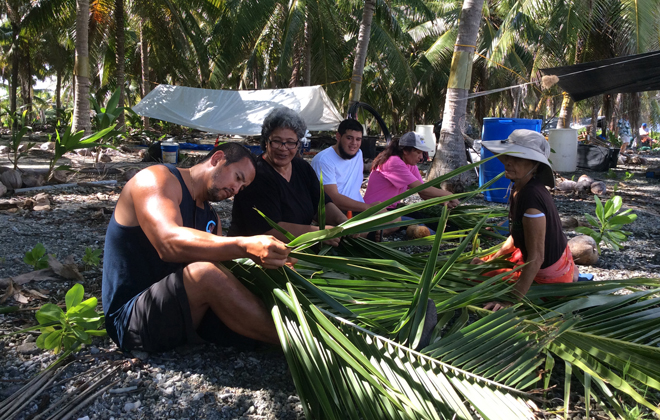Atoll envisioned as a model for sustainability

Above, crews unload supplies and an all-terrain vehicle onto Swains Island for a several-day visit to the remote, uninhabited atoll.

Alex Jennings monitors radio chatter and coconut crab being prepared for breakfast on the atoll.

Hokule‘a crew member Eric Co learns to weave using palm fronds on Swains Island.



SWAINS ISLAND » It’s eerily quiet on this tiny, uninhabited South Pacific atoll — almost no noise except for the akiaki birds squawking in the trees and the wind rustling through the palms.
Abandoned dwellings, gravestones and other mysterious artifacts scattered across the island offer a glimpse of a small community that thrived here decades ago, until the collapse of the local copra (dried coconut) industry in the 1960s prompted an exodus.
Eventually no one was left.
On a recent Friday, however, the rare sound of laughter echoes along Swains’ emerald-blue western shore. Island co-owner Alex Jennings and his extended family mingle as they prepare a breakfast feast of boiled coconut crabs and lobster harvested hours earlier. Spirits are high. They’ve finally come home.
This is more than a family camping trip. With each visit, Jennings, who left his native Swains as a boy, is gradually trying to put the island back on the map. And he wants to make it a model for sustainable living.
The family’s 40-person expedition arrived the previous day on the MV Sili supply vessel out of Pago Pago, Samoa, to spend a few precious days ashore. For several Swains natives, it was the first time they laid eyes on their birthplace in about 60 years.
Don't miss out on what's happening!
Stay in touch with breaking news, as it happens, conveniently in your email inbox. It's FREE!
"I cried. I was so happy to see the island," said San Diego resident Siniva Lopez, who was 8 years old when her family left in 1953. "Everything I see, where I grew up, life was good."
Jennings says he hopes to resettle Swains with some of the same the tight-knit Tokelauan and Samoan community that first arrived here in 1856.
He also has a unique opportunity: to redesign an entire island from scratch.
It’s still early, but Jennings says he envisions a Swains powered entirely by renewable energy, with simple dwellings — not luxury resorts — to house researchers and visitors interested in conservation.
It’s this dual push to revitalize Swains’ culture and promote sustainable living that brought Hawaii voyaging canoes Hokule‘a and Hikianalia to the island, the latest stop in their Malama Honua ("Care for the Earth") worldwide sail.
Jennings hopes the canoes’ visit, and the prestige they hold in the Pacific, can further help transform the island. The tiny atoll, he said, receives just $50,000 a year out of a total annual budget of nearly $500 million for American Samoa — about enough for a single expedition there each year. It’s not enough to get things moving.
Part of the problem is that Swains’ relationship to American Samoa and the United States isn’t clearly defined. Until it is, the island won’t see more political support, Jennings added. He also represents Swains as a nonvoting delegate in American Samoa’s legislature.
The U.S. Interior Department lists Swains as having joined the American Samoa territory in 1925. But Jennings says the issue is far more complex. Swains, he said, is actually a separate U.S. territory, even though it’s represented through American Samoa.
In 2013, in a move to spur more support for the island, the waters extending 3 miles around Swains became a national marine sanctuary. The move was a no-brainer because Swains residents have always carefully protected the 3-square-mile island’s resources anyway, Jennings family members say.
"Everything on this island was strictly preserved. Our ocean was our greatest resource," he said. "I always wanted Swains to be a model for green energy. I just didn’t know how to do it."
Swains’ new marine sanctuary has attracted other high-profile visitors as well. Last year, renowned ocean explorer Jean Michele Cousteau visited the island and dived among its reefs. He dubbed Swains the "Jewel of the Pacific."
Cousteau then suggested that the canoes visit Swains, Hokule‘a captain Nainoa Thompson said.
Thompson brought with him on this voyage leg Henk Rogers, founder and board chairman of the Hawaii-based Blue Planet Foundation, in part to discuss with Jennings ways to make the island energy independent.
But what’s important about Swains goes deeper than any green-energy concept, Thompson added. "What’s missing in the rest of the world that’s in Swains is that there’s a deep connection to this place," he told the expedition Saturday. "Everybody is deeply connected to home."
Historically, Swains’ residents had no choice but to rely on themselves. A ship would arrive only about every three months to collect the 40 or so tons of burlap-wrapped copra that they’d produced and stored in a large, central barn to dry since the previous visit. Then they’d be on their own again for several more months.
"Life was very simple," recalled Ruth Brown, Lopez’s younger sister and now a Kapolei resident. No television, no videos. The men would play cricket. Children would play a game of keep-away on the beach using a noni fruit. Kids would have to leave the island after sixth grade to continue their schooling.
The community of 100 or so people was devoutly religious and would attend services every Sunday. The church, built on stilts in the 1880s, has withstood hurricanes and tsunamis to remain standing today, Jennings said.
Residents relied on the rainwater they caught to drink, and they often bathed in the island’s central freshwater lagoon.
"It’s really nice here," Vaovasa added. "I would come back to visit. Would’ve been nice if there were people here."
Lopez said it will be difficult to board the Sili, leave Swains and make the daylong journey back to Pago Pago. "I know I can survive here. If I have a chance, I’ll live here," she said. Other family members on the expedition came from Seattle and Oahu.
On Friday evening Jennings sang a traditional song in Tokelauan to bid several crew members farewell moments before they returned to Hokule‘a, drifting offshore. He grew emotional as he sang, and it became difficult for him to finish. The song has come to symbolize the Jennings family’s own departure from Swains.
The main lines translate to "flock of birds preparing to fly to the sea, I cry as I journey out to the ocean blue — Swains disappearing from my eyes."




